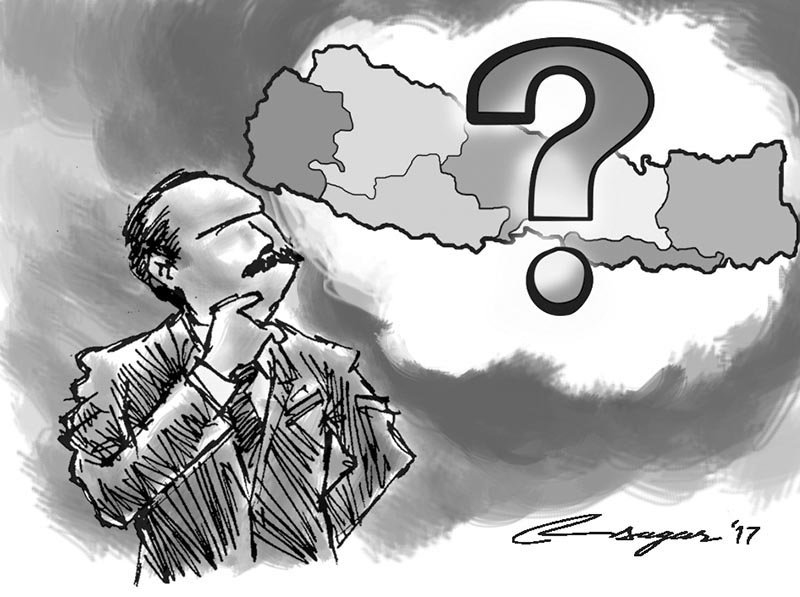Provincial capitals: Well-thought-out plan needed
It is crucial to understand the concept of a capital city in the 21st century. What makes a city a capital city? What prerequisites are to be fulfilled? Has the concept of the capital city changed over time?
With the recent federal and provincial elections under the new constitution, Nepal is now on its way to implementing federalism. Just as a new government is set to take shape at the centre, a heated debate has surfaced over determining the capitals of the seven provinces.
On one hand, there is a lack of institutional, financial and infrastructural resources in most of the provinces. And on the other, declaring provincial capital cities randomly may not be a good start for the country’s development process, something political leaders have promised.
Nevertheless, declaring capital cities is an exigent matter as they are quintessential for smooth functioning of newly carved out provinces.
Firstly, it is crucial to understand the concept of a capital city in the 21st century. What makes a capital city a capital city? What prerequisites are to be fulfilled? Has the concept of the capital city changed over time?
There are, however, some widely accepted criteria for selecting capital cities.
Generally, the location of a capital city is roughly equidistant from the competing population centres (for example, Madrid is located approximately at the centre of Spain)
Infrastructural requirements such as institutional buildings, buildable/ developable area for further expansion of the city, efficient public transportation and waste management system among others are vital components, without which a city cannot function as a capital city.
For inclusive and balanced development, it is argued that the capital city should not be the largest city in its region (for example. the capital city of Australia is Canberra even though Sydney and Melbourne are the two largest cities). At times, a city with pleasant climate and high aesthetic value is preferred over other cities (for example, Tanzania shifted its capital from Dar es Salaam to Dodoma, and one of the reasons for doing that was climate)
Unlike in earlier days, isolated capital cities and extravagant utopias are not desirable in today’s era. Instead, capital cities are located such that a backward neglected region gets uplifted and acts as an impetus for regional growth and a stimulator for investment (for example, Brasilia in Brazil was deliberately located in the hinterlands).
In addition, the concept of multiplicity can also be applied in capital cities’ formation. This means that a nation or a province can have more than one or two capital cities. Especially, in a democratic country like Nepal, the legislature, executive bodies and administration, and judiciary can function from different locations. The system of multiple capital cities is practised in several countries like Tanzania, Malaysia, the Netherlands, South Africa and Sri Lanka.
In Malaysia, Kuala Lumpur is the official royal capital, and the seat of national legislature, while Putrajaya is the administrative centre and the seat of its national judiciary. Similarly, in the Netherlands, Amsterdam is the official royal capital, while The Hague is the administrative centre, the seat of its national legislature and the seat of its national judiciary.
Sri Lanka also has two capital cities with Sri Jayawardenepura Kotte as the administrative capital and the seat of its national legislature, and Colombo as the commercial capital and the seat of its national executive and judicial bodies.
South Africa is one good example of a country with multiple capital cities. Pretoria is the administrative and executive capital; Cape Town is the legislative capital and Bloemfontein is the judicial capital.
Thus, provinces of Nepal can also have multiple capital cities. Each capital city would be equally important for effective implementation of the new constitution as well as for better execution of federalism.
Besides, multiple capital cities will aid to strike a balance between different regions within a province. It is said that new capital cities whose locations provide balance and inclusivity on as many levels as possible—territorial, economic, ethnic, religious—are likely to become more successful.
Furthermore, an entire city can be planned, built and operated as a capital city. This has been practised in many countries around the globe (Chandigarh, India; Islamabad, Pakistan; Astana, Kazakhstan; Brasilia, Brazil; Naypyidaw, Myanmar; and Canberra, Australia). However, cities built from scratch are widely criticised by some scholars, such as Brasilia (Brazil) has been labelled as a barren city with unwalkable streets and Naypyidaw of Myanmar if often called a glaringly lit ghost town.
Meanwhile, it is also argued that it is unrealistic to expect a new, planned city to become functional right away.
For instance, Washington, DC, wasn’t a vibrant metropolis for many years where Pierre L’Enfant’s master plan was completed only after 100 years of DC’s formation. Moreover, the location of a capital city can be time bounded. A city can function as a capital for 50 years after which the capital can be shifted to an existing or a newly developed city. Nepal’s provincial capitals can follow this approach to achieve a balanced economy, social justice and power-sharing within the provinces.
For example, in Province 1, Itahari can be the capital city for 50 years before it is shifted to Dhankuta. The duration for changing the location of a capital city can only be ascertained after an in-depth research and contextualisation of foreign case studies.
Khanal is urban planner, Urban Researcher & LEED Green Associate






